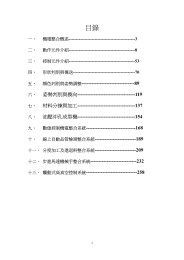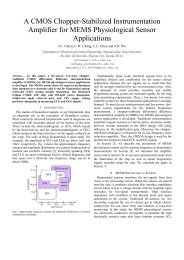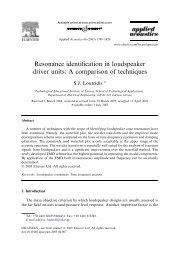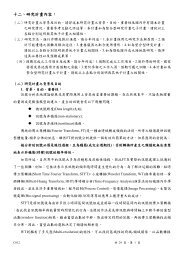IRIS RECOGNITION BASED ON HILBERT–HUANG TRANSFORM 1 ...
IRIS RECOGNITION BASED ON HILBERT–HUANG TRANSFORM 1 ...
IRIS RECOGNITION BASED ON HILBERT–HUANG TRANSFORM 1 ...
You also want an ePaper? Increase the reach of your titles
YUMPU automatically turns print PDFs into web optimized ePapers that Google loves.
Iris image preprocessing<br />
Iris image Localization<br />
Normalization<br />
Iris Recognition Based on Hilbert–Huang Transform 625<br />
Feature<br />
extraction Classification<br />
HHT LDA<br />
Fig. 1. Diagram of the proposed method.<br />
Output<br />
i.e. an iris image is generally periodical to some extent. Therefore the approximate<br />
period is an effective feature for the iris recognition. By employing the main frequency<br />
center presented in our previous works 26,27 of the Hilbert marginal spectrum<br />
as an approximation for the period of an iris image, a new iris recognition method<br />
based on HHT is proposed in this paper. Unlike directly using the residue of the<br />
EMD decomposed iris image for recognition in Ref. 5, the proposed method utilizes<br />
the main frequency center information as the feature vector which is particularly<br />
rotation invariant. In comparison with the existing iris recognition methods, the<br />
proposed algorithm has an excellent percentage of correct classification, and possesses<br />
very nice properties, such as translation invariance, scale invariance, rotation<br />
invariance, illumination invariance and robustness to high frequency noise. Figure 1<br />
illustrates the main steps of our method.<br />
The remainder of this paper is organized as follows. Brief descriptions of image<br />
preprocessing are provided in Sec. 2. A new feature extraction method and matching<br />
are given in Sec. 3. Experimental results and discussions are reported in Sec. 4.<br />
Finally, conclusions of this paper are summarized in Sec. 5.<br />
2. Iris Image Preprocessing<br />
An iris image, contains not only the iris but also some irrelevant parts (e.g. eyelid,<br />
pupil, etc.). A change in the camera-to-eye distance may also result in variations in<br />
the size of the same iris. Therefore, before feature extraction, an iris image needs<br />
to be preprocessed to localize and normalize. Since a full description of the preprocessing<br />
method is beyond the scope of this paper, such preprocessing is introduced<br />
briefly as follows.<br />
The iris is an annular part between the pupil (inner boundary) and the sclera<br />
(outer boundary). Both the inner boundary and the outer boundary of a typical iris<br />
can approximately be taken as circles. This step detects the inner boundary and<br />
the outer boundary of the iris. Since the localization method proposed in Ref. 14 is<br />
a very effective method, we adopt it here. The main steps are briefly introduced as<br />
follows. Since the pupil is generally darker than its surroundings and its boundary<br />
is a distinct edge feature, it can be found by using edge detection (Canny operator<br />
in experiments). Then a Hough transform is used to find the center and radius of<br />
the pupil. Finally, the outer boundary will be detected by using edge detection and

















